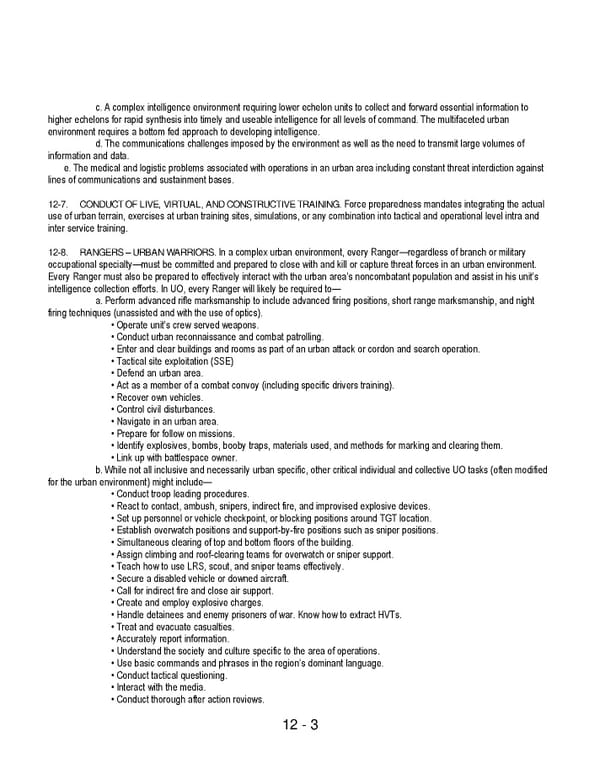12 - 3 c. A complex intelligence environment requiring lower echelon units to collect and forward essential information to higher echelons for rapid synthesis into timely and useable intelligence for all levels of command. The multifaceted urban environment requires a bottom fed approach to developing intelligence. d. The communications challenges imposed by the environment as well as the need to transmit large volumes of information and data. e. The medical and logistic problems associated with operations in an urban area including constant threat interdiction against lines of communications and sustainment bases. 12-7. CONDUCT OF LIVE, VIRTUAL, AND CONSTRUCTIVE TRAINING. Force preparedness mandates integrating the actual use of urban terrain, exercises at urban training sites, simulations, or any combination into tactical and operational level intra and inter service training. 12-8. RANGERS – URBAN WARRIORS. In a complex urban environment, every Ranger—regardless of branch or military occupational specialty—must be committed and prepared to close with and kill or capture threat forces in an urban environment. Every Ranger must also be prepared to effectively interact with the urban area’s noncombatant population and assist in his unit’s intelligence collection efforts. In UO, every Ranger will likely be required to— a. Perform advanced rifle marksmanship to include advanced firing positions, short range marksmanship, and night firing techniques (unassisted and with the use of optics). • Operate unit’s crew served weapons. • Conduct urban reconnaissance and combat patrolling. • Enter and clear buildings and rooms as part of an urban attack or cordon and search operation. • Tactical site exploitation (SSE) • Defend an urban area. • Act as a member of a combat convoy (including specific drivers training). • Recover own vehicles. • Control civil disturbances. • Navigate in an urban area. • Prepare for follow on missions. • Identify explosives, bombs, booby traps, materials used, and methods for marking and clearing them. • Link up with battlespace owner. b. While not all inclusive and necessarily urban specific, other critical individual and collective UO tasks (often modified for the urban environment) might include— • Conduct troop leading procedures. • React to contact, ambush, snipers, indirect fire, and improvised explosive devices. • Set up personnel or vehicle checkpoint, or blocking positions around TGT location. • Establish overwatch positions and support-by-fire positions such as sniper positions. • Simultaneous clearing of top and bottom floors of the building. • Assign climbing and roof-clearing teams for overwatch or sniper support. • Teach how to use LRS, scout, and sniper teams effectively. • Secure a disabled vehicle or downed aircraft. • Call for indirect fire and close air support. • Create and employ explosive charges. • Handle detainees and enemy prisoners of war. Know how to extract HVTs. • Treat and evacuate casualties. • Accurately report information. • Understand the society and culture specific to the area of operations. • Use basic commands and phrases in the region’s dominant language. • Conduct tactical questioning. • Interact with the media. • Conduct thorough after action reviews.
 Ranger Handbook Page 226 Page 228
Ranger Handbook Page 226 Page 228